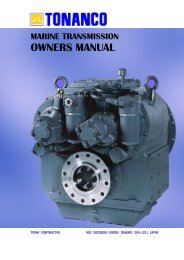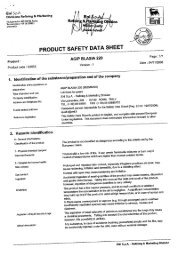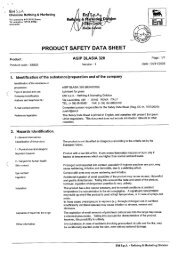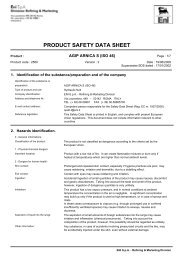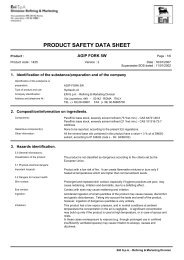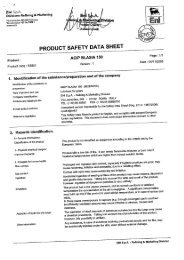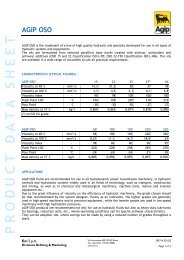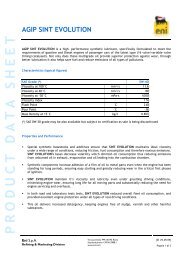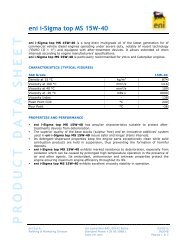HMC MSDS, Greases - TransDiesel
HMC MSDS, Greases - TransDiesel
HMC MSDS, Greases - TransDiesel
You also want an ePaper? Increase the reach of your titles
YUMPU automatically turns print PDFs into web optimized ePapers that Google loves.
Material Safety Data Sheet<br />
Moly Lithtac EP 2<br />
Non-hazardous Substance<br />
Non-dangerous Goods<br />
Issue Date<br />
Status<br />
October, 2008<br />
Issued by Harrison Manufacturing<br />
COMPANY DETAILS<br />
Company Name<br />
Address<br />
Telephone Number<br />
Fax Number<br />
Emergency Phone<br />
Number<br />
Harrison Manufacturing Company Pty Ltd (ABN 50 000 080 946)<br />
75 Old Pittwater Road BROOKVALE NSW 2100 AUSTRALIA<br />
61 2 8978 1000<br />
61 2 9905 0065<br />
61 2 8978 1000 (9:00am - 5:00pm AEST, Monday to Friday)<br />
PRODUCT IDENTIFICATION<br />
Product Name<br />
UN Proper Shipping<br />
Name<br />
Other Names<br />
Recommended Use<br />
Moly Lithtac EP 2<br />
None allocated<br />
None listed<br />
Multipurpose lithium soap based grease.<br />
Section 2: HAZARDS IDENTIFICATION<br />
NOHSC Classification<br />
ADG Classification<br />
SUSDP Classification<br />
Risk Phrases<br />
Safety Phrases<br />
Not classified as hazardous according to criteria of NOHSC.<br />
Not classified as a Dangerous Good according to the Australian Code for the<br />
Transport of Dangerous Goods by Road and Rail.<br />
Note: Combustible materials may be classified as Class 9: miscellaneous<br />
dangerous goods if transported with flammable materials. See ADG code for<br />
further information.<br />
Not Scheduled<br />
None<br />
None<br />
Section 3: COMPOSITION/INFORMATION ON INGREDIENTS<br />
Name CAS Proportion Risk Phrases<br />
Solvent-dewaxed petroleum residual oil 64742-62-7 30 to 60% -<br />
Distillates (petroleum) solvent dewaxed, heavy paraffinic 64742-65-0 10 to 30% -<br />
Other ingredients determined not to be hazardous Not required 10 to 30% -<br />
Solvenerfined highly naphthenic distillate 64741-96-4 10 to 30% -<br />
Section 4: FIRST AID MEASURES<br />
Page 1 of 5
Swallowed<br />
Eye<br />
Skin<br />
Inhaled<br />
First Aid Facilities<br />
Advice to Doctor<br />
DO NOT induce vomiting. Immediately wash out mouth with water, and then give<br />
plenty of water to drink. Seek medical attention.<br />
Rinse eyes immediately with water for at least 15 minutes. In case of irritation,<br />
seek medical advice.<br />
Remove all contaminated clothing. Wash gently and thoroughly with water and nonabrasive<br />
soap. Ensure contaminated clothing is washed before re-use or discard.<br />
If irritation develops and persists, seek medical attention. Should grease be<br />
accidentally injected under the skin no matter how minor, seek IMMEDIATE<br />
medical attention.<br />
Remove the patient to fresh air. Ensure airways are clear and have qualified<br />
person give oxygen through a facemask if breathing is difficult. If irritation<br />
develops, seek medical attention.<br />
No special facilities required.<br />
Treat symptomatically.<br />
NOTE: High Pressure Applications: Injections under the skin resulting from contact<br />
with high pressure, constitutes a major medical emergency. Injuries may not<br />
appear serious at first but within a few hours, tissue becomes swollen, discoloured<br />
and extremely painful with extensive subcutaneous necrosis. Surgical exploration<br />
should be undertaken without delay. Thorough and extensive debridement of the<br />
wound and underlying tissue is necessary to minimise tissue loss and prevent or<br />
limit permanent damage. Note that the high pressure may force the product<br />
considerable distance along tissue.<br />
Section 5: FIRE FIGHTING MEASURES<br />
Fire/Explosion<br />
Hazard<br />
Extinguishing Media<br />
Fire Fighting<br />
Precautions<br />
Flash Point<br />
Hazchem Code<br />
Hazards from<br />
Combustion<br />
Products<br />
Classified as C2 (Combustible liquid).<br />
Use water as fog or spray to cool fire exposed containers. Do not use direct<br />
stream of water; product will float, possibly re-igniting.<br />
Self-Contained Breathing Apparatus (SCBA) and full protective clothing should be<br />
worn.<br />
> 240°C (COC)<br />
None allocated<br />
Oxides of carbon.<br />
Section 6: ACCIDENTAL RELEASE MEASURES<br />
Spills Procedure<br />
SMALL - 20 LITRES OR LESS<br />
Soak up with inert oil absorbent. Arrange for disposal through an approved<br />
facility.<br />
LARGE - GREATER THAN 20 LITRES<br />
Remove all sources of ignition. Increase ventilation. Evacuate all unnecessary<br />
personnel. Wear full protective equipment and clothing to minimise exposure. If<br />
possible contain the spill. Place inert absorbent material such as vermiculite, sand<br />
or dirt onto spillage. Use clean non-sparking tools to collect the material and place<br />
into a suitable labelled container. If large quantities of this material enter the<br />
waterways contact the Environmental Protection Authority, or your local Waste<br />
Management Authority.<br />
Section 7: HANDLING AND STORAGE<br />
Page 2 of 5
Handling<br />
Storage Precautions<br />
Repeated or prolonged contact with this material should be avoided in order to<br />
lessen the possibility of skin disorders. It is essential that all who come into<br />
contact, maintain high standards of personal hygiene ie. washing hands prior to<br />
eating, drinking or going to the toilet. Build-up of mists in the working atmosphere<br />
must be prevented.<br />
Misuse of empty containers can be hazardous. Do not cut, weld, heat or drill<br />
containers. Residue may ignite with explosive violence if heated sufficiently. Do<br />
not pressurise or expose to open flame or heat. Keep container closed and bung in<br />
place.<br />
Classified as a combustible substance for storage and handling purposes. Store in<br />
a cool, dry, well-ventilated area, out of direct sunlight. Avoid sparks, flames, and<br />
other ignition sources. Store away from incompatible materials such as materials<br />
that support combustion (oxidising materials). Reference should be made to<br />
Australian Standard AS1940- The storage and handling of flammable and<br />
combustible liquids.<br />
Section 8: EXPOSURE CONTROLS/PERSONAL PROTECTION<br />
Exposure Limits<br />
Biological Limit<br />
Values<br />
Engineering Control<br />
Respirator Type<br />
Eye Protection<br />
Glove Type<br />
Clothing<br />
No value assigned for this specific material by the National Occupational Health<br />
and Safety Commission (NOHSC). However, Exposure Standards for constituents<br />
are listed below.<br />
SUBSTANCE TWA STEL<br />
ppm mg/m³ ppm mg/m³<br />
Oil mist, mineral<br />
- 5 - 10<br />
Exposure Standard means the average concentration of a particular substance in<br />
the worker's breathing zone, exposure to which, according to current knowledge,<br />
should not cause adverse health effects nor cause undue discomfort to nearly all<br />
workers. It can be of three forms; time-weighted average (TWA), peak limitation,<br />
or short-term exposure limit (STEL).<br />
No biological limit allocated.<br />
The use of mechanical dilution ventilation is recommended whenever this<br />
product is used in a confined space, is heated above ambient temperatures or<br />
otherwise to maintain ambient concentration below the recommended threshold<br />
exposure limits.<br />
Avoid breathing vapours or mists. Select and use respirators in accordance with<br />
AS/NZS 1715/1716. When vapours are generated, the used of the following is<br />
recommended: Half face piece respirator with dust/mist filters. The appropriate<br />
filter capacity and respirator type will depend on exposure levels encountered.<br />
Chemical safety goggles are recommended. If handled hot, a full face shield<br />
should be worn.<br />
Use of impervious rubber gloves are recommended.<br />
Clothing should be suitable to avoid product contacting the skin on a prolonged or<br />
repeated basis.<br />
Section 9: PHYSICAL AND CHEMICAL PROPERTIES<br />
Appearance Grey/black tacky grease<br />
Odour<br />
Negligible<br />
Melting Point > 180°C<br />
Boiling Point Not available<br />
Vapour Pressure Not available<br />
Vapour Density Not available<br />
pH<br />
Not applicable<br />
Specific Gravity Approx. 0.9 g/cm 3<br />
Page 3 of 5
Flashpoint<br />
Flamm. Limit LEL<br />
Flamm. Limit UEL<br />
Solubility in Water<br />
> 240°C (COC)<br />
Not available<br />
Not available<br />
< 0.1 g/l<br />
Other Properties<br />
Worked Penetration<br />
(x60) @ 25°C 265 - 295<br />
Section 10: STABILITY AND REACTIVITY<br />
Stability<br />
Conditions to Avoid<br />
Incompatible<br />
Materials<br />
Hazardous<br />
Decomposition<br />
Products<br />
Hazardous Reactions<br />
Stable under normal conditions of storage and handling.<br />
None allocated.<br />
Strong oxidising agents.<br />
Oxides of carbon.<br />
No hazardous polymerisation will occur.<br />
Section 11: TOXICOLOGICAL INFORMATION<br />
Toxicology<br />
Acute - Swallowed<br />
Acute - Eye<br />
Acute - Skin<br />
Acute - Inhaled<br />
Chronic<br />
The classification as a carcinogen need not apply in this case as the main<br />
constituents in this product are in accordance with Note L of the NOHSC<br />
Designated List of Hazardous Substances (containing less than 3% DMSO extract<br />
as measured by IP 346).<br />
May cause irritation to the mouth, oesophagus and stomach. Symptoms may<br />
include nausea, vomiting and diarrhoea.<br />
May cause slight to moderate eye irritation, resulting in redness and stinging.<br />
May dry and defat the skin, resulting in skin irritation and possible dermatitis.<br />
Grease accidentally injected under the skin can result in local necrosis and tissue<br />
damage.<br />
May cause irritation to the mucous membrane and upper airways, especially if the<br />
material is heated or mists are generated and/or is used in poorly ventilated areas.<br />
Symptoms may include headache, dizziness and nausea.<br />
Prolonged or repeated contact with this material may result in skin irritation leading<br />
to dermatitis.<br />
Section 12: ECOLOGICAL INFORMATION<br />
Ecotoxicity<br />
Persistence and<br />
Degradability<br />
Mobility<br />
No ecotoxicological classifications.<br />
This product is inherently biodegradable.<br />
Spillages are unlikely to penetrate the soil.<br />
Section 13: DISPOSAL CONSIDERATIONS<br />
Disposal Method<br />
Special Disposal<br />
Precautions<br />
Dispose of waste according to federal, EPA, state and local regulations. Assure<br />
conformity with all applicable regulations.<br />
None allocated.<br />
Page 4 of 5
Section 14: TRANSPORT INFORMATION<br />
UN Number<br />
UN Proper Shipping<br />
Name<br />
DG Class<br />
Packaging Group<br />
Hazchem Code<br />
Special Transport<br />
Precautions<br />
None allocated<br />
None allocated<br />
Not classified as a Dangerous Good according to the Australian Code for the<br />
Transport of Dangerous Goods by Road and Rail.<br />
Note: Combustible materials may be classified as Class 9: miscellaneous<br />
dangerous goods if transported with flammable materials. See ADG code for<br />
further information.<br />
None allocated<br />
None allocated<br />
None allocated<br />
Section 15: REGULATORY INFORMATION<br />
AICS<br />
All ingredients present on AICS.<br />
Section 16: OTHER INFORMATION<br />
Last Revision<br />
Acronyms<br />
October, 2008<br />
ABN Australian Business Number<br />
ACGIH American Conference of Governmental Industrial Hygienists<br />
ADG Australian Dangerous Goods<br />
AEST Australian Eastern Standard Time<br />
AICS Australian Inventory of Chemical Substances<br />
CAS Chemical Abstacts Service Registry Number<br />
COC Cleveland Open Cup<br />
DG Class Dangerous Goods Class.<br />
EPA Environment Protection Agency<br />
Hazchem Code of numbers and letters which gives information to emergency<br />
services.<br />
IP Institute of Petroleum<br />
PMCC Pensky-Martens Closed Cup<br />
NOHSC National Occupational Health and Safety Commission<br />
SUSDP Standard for the Uniform Scheduling of Drugs and Poisons<br />
UN Number United Nations Number<br />
CONTACT POINT<br />
Contact<br />
Technical Manager<br />
Telephone 61 2 8978 1000<br />
IMPORTANT<br />
DISCLAIMER<br />
All reasonable care has been taken to ensure that the information and advice<br />
contained herein are accurate at the time of printing. However, Harrison<br />
Manufacturing Co accepts no tortious or contractual liability for any loss or<br />
damages suffered as a consequence of reliance on the information and advice<br />
contained herein.<br />
End of <strong>MSDS</strong><br />
Page 5 of 5



